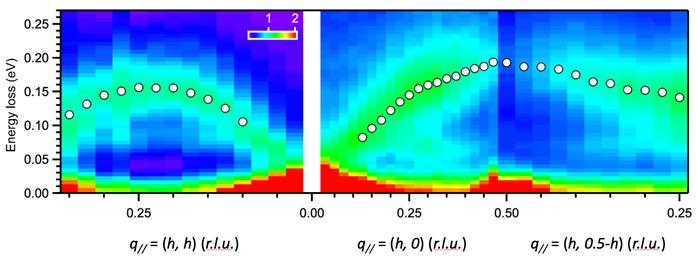The discovery of the first high-temperature superconductor in 1986 brought with it the hope that superconductivity would one day revolutionise power transmission, electronic devices and other technologies. Materials that show superconductivity (zero electrical resistance) generally do so at an extremely low temperature. For their use to become widespread and world-changing, we need to develop a material that is superconducting close to room temperature. Research showed that the first high-temperature superconductor - a copper oxide compound - was part of a family of materials known as cuprates. Scientists have found cuprates that are superconducting at temperatures as high as 133.5 K. However, we don't fully understand how superconductivity arises in the high temperature superconductors. In 2019, the discovery of superconductivity in a nickel oxide compound opened up new avenues of research. Scientists can now compare this nickelate material to cuprates to discover the similarities and differences. In a study recently published in Science, researchers at Diamond, SLAC, Stanford University, and Leiden University, used Resonant Inelastic X-ray Scattering (RIXS) to study the magnetic properties of the nickelate superconductor. Their results shed light on the underlying physics that gives rise to superconductivity.

The discovery of superconductivity in a second family of materials offers the opportunity to assess their similarities and differences and could bring us closer to understanding how high-temperature superconductivity arises.

For superconductivity to occur, electrons that normally repel each other (due to their identical charge) have to become attractive. Electrons pair up, and at a low enough temperature (the critical temperature for the material, Tc), they condense to form a superfluid that flows without friction. Zero electrical resistance is the result. Copper oxides are antiferromagnetic, whose spins align in a regular pattern with neighboring spins pointing in opposite directions forming long-range order. One theory as to why zero resistance in cuprates is that the residual spin fluctuations of the moving electrons may cause them pair up.
In 2019, researchers from Stanford and the SLAC overcame considerable challenges to produce the nickelate Nd0.8Sr0.2NiO2 and found that it is superconducting at around 9-15 K. The nickelate material has a crystal structure similar to that of cuprates, but would its electrons behave in the same way?
These superconducting materials are prepared as thin nickel or copper oxide sheets sandwiched between layers of other elements, such as rare-earth ions. These are "doped", adjusting the density of free-flowing electrons. Before being doped, cuprate materials are insulators with electrons that do not move around. After doping, the electrons move freely in their cuprate layers, rarely travelling into the rare-earth layers.
In work published in Nature Materials in 2020, studies carried out on Diamond's I21 beamline showed that the electron behaviour in nickelates is very different. An undoped nickelate is a metallic material with free-flowing electrons that move between layers, creating a 3D metallic state.

Another interesting facet of the superconductor conundrum is that - so far - the nickelates do not show the same kind of magnetic order seen in cuprates. To investigate further, it was back to the RIXS beamline.
Principal beamline scientist Ke-Jin Zhou explains:
RIXS is the only technique powerful enough to analyse the tiny magnetic signals coming from the nickelate sample. It's a minute sample, a tiny volume of the material, and I21 has the most advanced RIXS instrument in the world. We achieved spectacular results. I was amazed that the entire spectrum from the nickelate is so similar to that of a cuprate in terms of magnetic fluctuation. This is the first experimental confirmation of magnetic behaviour in the nickelate superconductor.
These results shed some light on the mechanisms underlying superconductivity. They bring us one step closer to the day we can develop a room-temperature superconductor and explore the many benefits of these remarkable materials.
To find out more about the I21 beamline or discuss potential applications, please contact Ke-Jin Zhou: [email protected].
Lu H et al. Magnetic excitations in infinite-layer nickelates. Science. 373.6551 (2021): 213-216. DOI: 10.1126/science.abd7726
Hepting M et al. Electronic structure of the parent compound of superconducting infinite-layer nickelates. Nature materials 19.4 (2020): 381-385. DOI:10.1038/s41563-019-0585-z.
H. Robarts et al. Dynamical spin susceptibility in La2CuO4 studied by resonant inelastic x-ray scattering. Phys. Rev. B 103, 224427 (2021).
Diamond Light Source is the UK's national synchrotron science facility, located at the Harwell Science and Innovation Campus in Oxfordshire.
Copyright © 2022 Diamond Light Source
Diamond Light Source Ltd
Diamond House
Harwell Science & Innovation Campus
Didcot
Oxfordshire
OX11 0DE
Diamond Light Source® and the Diamond logo are registered trademarks of Diamond Light Source Ltd
Registered in England and Wales at Diamond House, Harwell Science and Innovation Campus, Didcot, Oxfordshire, OX11 0DE, United Kingdom. Company number: 4375679. VAT number: 287 461 957. Economic Operators Registration and Identification (EORI) number: GB287461957003.